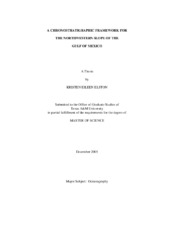| dc.description.abstract | Sediments from two cores, JPC31 and JPC46, were analyzed to better understand
the relationship between climate and sediment deposition on the continental slope of the
northwestern Gulf of Mexico. These two cores were selected from a suite of cores
collected from the slope of the Gulf of Mexico after examining how bulk density varied
with depth in the cores. The presence/absence of Globoratalia menardii, down-core
variations of the 18O of Globigerinoides ruber, tephrochronology, and radiocarbon dating
of G. ruber were used to determine the chronologies of the sediments in the cores.
Globorotalia menardii were present until a depth of 100 cm in JPC31. The entrance of G.
menardii in the Gulf of Mexico was dated at 8 kyr. Analysis of an ash layer found in both
JPC31 and 46 yielded a date of 84 kyr, at depths of 700 cm and 1440 cm, respectively.
Radiocarbon dating yielded four ages in JPC31. In sediment core JPC31, Marine Isotope
Stage (MIS) 1-5 were recorded. In sediment core JPC46, MIS 2-4 and a portion of MIS 5
were recorded.
These results provide a framework for determining general sedimentation rates
from the northwestern slope of the Gulf of Mexico. Events in the density profiles in JPC31
and JPC46 were correlated to corresponding events in the rest of the slope cores, allowing
the chronologies of JPC31 and JPC46 to be transferred to the suite of the slope cores.
Sedimentation rates along different portions of the slope were then calculated, and
variations in these sedimentation rates were used to better understand slope sedimentary
processes. Sedimentation rates on the northwestern slope of the Gulf of Mexico were
calculated for the most recent 120,000 years and compared with climate to deduce trends.
Sedimentation rates for MIS 1-5 ranged from 7 cm/kyr to 28 cm/kyr. The sedimentation
rate for the last glaciation (MIS 2, 3, and 4) were the highest for the time interval studied.
The lowered sea level during glacial advances brings sediments farther out onto the slope;
therefore, a higher sedimentation rate is expected during this time. These rates varied from
22 cm/kyr near the coast to 7 cm/kyr toward the abyssal plains. Of the 12 cores analyzed
along the slope, JPC23 and JPC24 had the lowest sedimentation rates. This is likely due to
high density bottom currents and turbidity currents which carry sediments farther out on
the slope. Therefore, the lowest sedimentation rates would be expected a great distance
from the land mass and some distance from the abyssal plains. | en |


